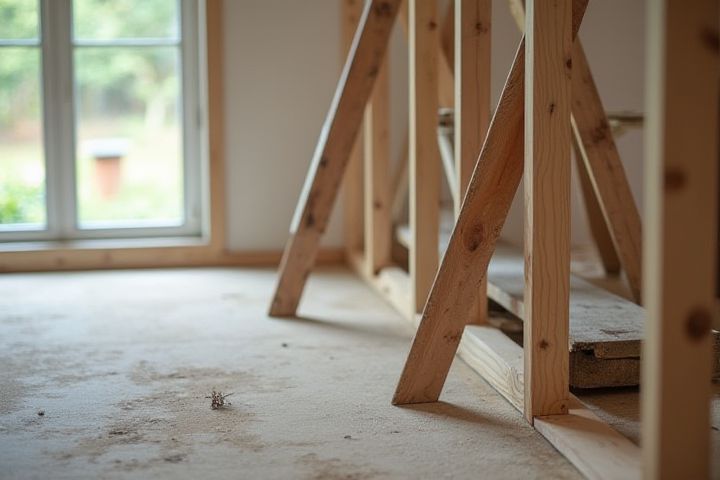
Living in a house during renovations is possible but requires careful planning and consideration. You should assess the level of disruption involved; minor updates may allow for comfortable living, whereas major renovations can create noise, dust, and hazardous materials. It's essential to designate specific areas as "safe zones" to maintain your daily routine. Ensuring proper ventilation is crucial to avoid air quality issues due to paint fumes and chemicals. Finally, having a clear communication plan with contractors can help minimize stress and streamline the renovation process, allowing you to stay home without significant inconvenience.
Can You Live In A House During Renovations
Air quality considerations
Living in a house during renovations can significantly impact air quality, primarily due to dust, volatile organic compounds (VOCs), and other airborne pollutants released during construction. Studies indicate that renovation work can increase particulate matter levels by up to 50%, which can aggravate respiratory issues and allergies. To mitigate these effects, maintaining proper ventilation is crucial; using HEPA filters and air purifiers can reduce harmful particulates and improve indoor air quality. It's also recommended to schedule heavy work for when the house is unoccupied to minimize exposure to hazardous materials.
Noise disruptions
Living in a house during renovations can subject you to significant noise disruptions, with levels often exceeding 85 decibels depending on the type of work being done. For instance, the sounds of power tools, hammering, and heavy machinery can create a continuous disturbance that may last for several hours each day. This constant noise can lead to increased stress levels and disrupt your daily routines, including sleep. If you decide to stay, consider using earplugs or noise-canceling headphones to help mitigate the impact on your comfort and well-being.
Utility interruptions
Living in a house during renovations can pose significant challenges, especially due to utility interruptions. Water, electricity, and gas services may be temporarily cut off or restricted, impacting daily tasks such as cooking, bathing, and heating. You may experience scheduled outages, which can last from a few hours to several days, depending on the scope of the work. It's crucial to plan ahead by securing alternative arrangements, such as access to portable utilities or nearby facilities, to maintain a semblance of normalcy during the renovation process.
Dust and debris management
Living in a house during renovations is possible, but effective dust and debris management is essential for your comfort and health. Utilizing HEPA air purifiers can reduce airborne particles by up to 99.97%, providing cleaner air in your living space. Seal off construction areas with plastic sheeting to contain dust, and employ heavy-duty drop cloths to protect floors and furniture from debris. Regular cleaning with a vacuum equipped with a HEPA filter can minimize dust accumulation, ensuring a more livable environment during the renovation process.
Safety precautions
Living in a house during renovations can expose you to various risks, making safety precautions essential. Ensure that all hazardous areas are properly sealed off with barriers to prevent dust and debris from entering your living space. Use personal protective equipment, like masks and goggles, to safeguard against inhaling harmful particles. Regularly monitor air quality with a digital meter; maintaining levels below 200 mg/m3 for PM2.5 is crucial for your health throughout the renovation process.
Limited access to areas
Living in a house during renovations often means limited access to various areas, which can significantly impact your daily routine. Commonly affected spaces include the kitchen and bathrooms, as these are essential for cooking and personal hygiene. You may need to set up temporary living arrangements, such as a makeshift kitchen or using public facilities, to adapt to the restrictions. It's crucial to plan ahead and communicate with your contractor to understand which areas will be accessible and when, ensuring a smoother transition through the renovations.
Temporary living setup
Living in a house during renovations can be manageable with a well-thought-out temporary setup. Designate a specific area of the house, ideally separate from the construction zone, to serve as your living space, ensuring it is clean and comfortable. Essential items, such as portable cooking appliances and a mini-fridge, can facilitate basic meal preparation, while a designated sleep area provides rest. Consider investing in noise-canceling headphones or earplugs, as loud tools will be in use, helping to maintain your sanity and comfort during the process.
Communication with contractors
Communicating effectively with contractors during renovations is essential for maintaining a comfortable living environment. Ensure you establish clear timelines and expectations, discussing specific phases of the project to anticipate disruptions. Regular updates on progress, potential delays, and any necessary changes can help you adapt and prepare, minimizing stress. Utilize tools like shared calendars or messaging apps to maintain a constant line of communication, ensuring you remain informed about daily activities that may affect your home life.
Budget for unexpected costs
Living in a house during renovations can lead to unplanned expenses that may strain your budget. It's essential to set aside at least 10-20% of your renovation budget for unexpected costs, such as structural repairs or delays. You may encounter hidden issues like water damage or outdated wiring that require immediate attention, further increasing your financial commitment. Planning for these unexpected expenses ensures you can maintain your living situation comfortably while achieving your renovation goals.
Potential for extended timelines
Living in a house during renovations can lead to significant challenges, especially when dealing with extended timelines. Unforeseen structural issues, such as mold or outdated plumbing, can push back completion dates by several weeks or even months. You might find specific areas of your home, like kitchens or bathrooms, rendered unusable for long stretches, necessitating creative solutions for daily living. Planning ahead and maintaining realistic expectations is crucial to navigate potential disruptions effectively.
